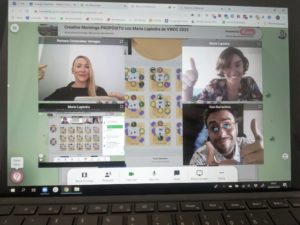Written by

Sina Brust
#virtualspacehero
We recently attended a compelling talk by Darren Murph titled, “The Future of Living: Trends Reshaping the Modern Workplace.” Darren, a seasoned expert in the future of work, shared his insights on how our approach to work is fundamentally altering our way of living. Here, we look into the key points from his presentation and explore how transforming the trends in modern workplaces are.

Darran Murph is named an “oracle of remote work” by CNBC and currently leads technology strategy communications at Ford Motor Company. Previously, he served as GitLab’s Head of Remote, establishing the company as a remote work pioneer and scaling it to become the world’s first fully remote company to IPO. Darran is also a published author, advisor, and mentor, dedicated to empowering people and companies to embrace remote work.
The Shift from Work to Living
Historians, a century from now, will label this era as “The Future of Living,” emphasizing that changes in our work culture are leading to broader societal shifts. This perspective sets the stage for understanding how deeply intertwined our work and personal lives have become.
The transition from the traditional concept of work to a more integrated concept of living is driven by the digital revolution and the increasing prevalence of remote work. As more companies adopt flexible work arrangements, employees find themselves blending work and personal life in ways that were previously unimaginable. This shift is not just about where we work but also about how we live our daily lives.
The Impact on Daily Life
Remote work has allowed people to reclaim time previously spent commuting, leading to more time for family, hobbies, and self-care. This change has a profound impact on mental health and overall well-being. Employees now have the flexibility to design their day around their peak productivity times, which can vary greatly from person to person. The traditional 9-to-5 workday is being replaced by more fluid schedules that accommodate individual lifestyles and preferences.
Moreover, this shift has geographical implications. People are no longer bound to live near their workplaces. This freedom has led to a migration from urban centers to more suburban or rural areas, where the cost of living might be lower and the quality of life higher. This trend is reshaping communities and local economies as the workforce’s distribution becomes more dispersed.
To thrive in this new world, organizations must prioritize health and intentionality in their design. Darren highlighted the importance of treating distributed work as a product rather than a policy. This approach involves a holistic consideration of various factors contributing to organizational health: direction, culture and climate, accountability, coordination and control, capabilities, motivation, external orientation, and innovation and learning.
The Role of Leadership
Leadership plays a crucial role in building a healthy organizational culture. Leaders must be proactive in creating an environment that supports both remote and in-office workers. This includes providing the necessary tools and resources for effective communication and collaboration. Regular check-ins and transparent communication help maintain a sense of community and ensure that all team members feel valued and included.
Furthermore, leaders must be mindful of the unique challenges that remote workers face, such as feelings of isolation and the blurring of work-life boundaries. Implementing wellness programs and encouraging a healthy work-life balance are essential strategies to support employees’ mental and physical health.
The Importance of Culture for Trends in Modern Workplaces
Creating a strong culture is essential in any organization, especially in distributed settings. Darren outlined three key elements that define culture: camaraderie, operating principles and values, and work methods. A critical step in building culture is to codify everything that might otherwise be implicit. Writing down operating procedures, communication norms, and feedback methods ensures consistency and clarity across geographies and languages.
1️⃣Camaraderie
Camaraderie in a distributed team requires deliberate effort. Without the benefit of spontaneous water cooler conversations, teams need structured opportunities to connect on a personal level. Virtual coffee breaks, team-building activities, and regular social events can help build strong interpersonal relationships. Sharing personal updates and celebrating milestones together can also foster a sense of community and belonging.
2️⃣Operating Principles and Values
A clear set of operating principles and values is the foundation of a strong organizational culture. These principles guide decision-making and behavior, ensuring that everyone is aligned with the company’s mission and goals. Regularly revisiting and reinforcing these values can help maintain a cohesive culture, even as the organization grows and evolves.
3️⃣Work Methods
Work methods should be designed to support the unique needs of a distributed team. This includes leveraging technology to facilitate collaboration and communication. Tools like project management software, video conferencing platforms, and instant messaging apps are essential for keeping teams connected and productive. Additionally, establishing clear protocols for meetings, project updates, and feedback can help streamline workflows and reduce misunderstandings.
💡 Here are some of our #VirtualSpaceHero favorites when it comes to collaboration tools: 1) Slack for asynchronous communication, 2) Trello for project management, 3) Toggl to keep track of our working hours and habits.
Tactical Examples for Culture Building
Here are our three favourite tips for building a strong culture in distributed teams:
1. Community Impact Outing: Replace virtual happy hours with activities that encourage team members to engage with their local communities and share their experiences. This not only builds camaraderie but also reinforces the company’s commitment to social responsibility.
2. Personal Operating Manual: Each team member creates a guide on how they prefer to work, communicate, and receive feedback. This helps colleagues understand each other’s work styles and preferences, facilitating smoother collaboration.
3. Connection Before Content: Start meetings with personal check-ins to strengthen team bonds before diving into work topics. This practice acknowledges the human aspect of work and helps build trust and rapport among team members.
Future Trends in Modern Workplaces
Darren discussed some fascinating statistics from the Future Forum team. In 2022, 79% of people wanted flexibility in where they work, and 94% wanted flexibility in when they work. This highlights the growing demand for not just remote work but also flexible schedules. To support this, organizations need systems and cultures that enable such flexibility.
🧩The Rise of the Non-Linear Workday
The traditional workday, structured around fixed hours, is giving way to the non-linear workday. This approach allows employees to work during their most productive hours, which may vary throughout the day. For example, someone might start their day early, take a break in the afternoon, and then resume work in the evening. This flexibility can lead to higher productivity and job satisfaction, as employees can better manage their work-life balance.
🧩Embracing Asynchronous Work
Asynchronous work refers to tasks that do not require real-time interaction. By embracing asynchronous work, organizations can reduce the need for constant meetings and allow employees to focus on deep work. This approach can be particularly beneficial for global teams operating across different time zones. Tools like collaborative documents, project management platforms (at #VirtualSpaceHero we usually use Trello), and recorded video updates enable effective asynchronous communication.
🧩The Placeless Taxonomy
The placeless taxonomy is a framework for understanding which tasks are best suited for asynchronous work. Tasks like informing, collaborating, and problem-solving can often be done without real-time interaction, freeing up synchronous time for more critical activities like connecting, innovating, and making decisions.
Implementing the placeless taxonomy can help teams prioritize their time and focus on high-value activities. By shifting routine updates and informational meetings to asynchronous formats, teams can reserve synchronous time for meaningful discussions and decision-making. This approach not only increases productivity but also empowers employees to take ownership of their schedules.
🧩Documentation as a Superpower
One of the most crucial aspects of effective distributed work is rigorous documentation. Organizations that excel in codifying their values, principles, and operating rhythms can onboard new employees faster and more effectively. Clear documentation also eliminates inefficiencies and ensures everyone knows how to navigate the workplace systems.
Encouraging a culture of documentation requires commitment from all levels of the organization. Leaders should model this behavior by documenting their processes and decisions. Teams should establish norms for documentation, such as using shared platforms for project updates and meeting notes. Regularly reviewing and updating documentation ensures that it remains relevant and useful.
The benefits of documentation extend beyond onboarding. It provides a reference point for employees, reduces the need for repetitive explanations, and ensures continuity in case of turnover. Additionally, well-documented processes can serve as a foundation for continuous improvement, as teams can identify areas for optimization and innovation.
Skills for the Future
Darren emphasized the need for certain “dark horse” skills to thrive in the future workplace, including storytelling and low-context communication. Low-context communication involves explaining things as if the audience has little prior knowledge, ensuring clarity and inclusivity.
🚀 The Power of Storytelling
Storytelling is a powerful tool for communication and leadership. It helps convey complex ideas in an engaging and relatable way. By framing information as a story, leaders can capture their audience’s attention and make their message more memorable. Storytelling can also build a sense of community and shared purpose within a team.
🚀 Mastering Low-Context Communication
Low-context communication is particularly important in distributed teams, where employees may come from diverse backgrounds and have varying levels of familiarity with the topic at hand. By assuming that the audience has little prior knowledge, communicators can ensure that their message is clear and accessible to everyone. This approach reduces misunderstandings and fosters a more inclusive environment.
The Psychology of Work
Darren touched on the psychological aspects of work, referencing a 2015 Google study that identified five elements necessary for effective teams: psychological safety, dependability, structure and clarity, meaning, and impact. Structure and clarity, often weak in distributed settings, are crucial for a shared understanding of vision, strategy, and success.
🌟Psychological Safety
Psychological safety is the foundation of a healthy team. It refers to the belief that team members can speak up, take risks, and express themselves without fear of negative consequences. Leaders can foster psychological safety by encouraging open communication, showing empathy, and valuing diverse perspectives.
🌟Dependability and Structure
Dependability and structure go hand in hand in creating an effective team. Dependability means that team members can rely on each other to meet deadlines and deliver quality work. Structure involves having clear roles, responsibilities, and processes. Together, these elements ensure that the team operates smoothly and efficiently.
The SCARF Model
Dr. David Rock’s SCARF model outlines five factors that influence people in the workplace:
Status,
Certainty,
Autonomy,
Relatedness, and
Fairness.
Understanding these factors helps leaders design policies and procedures that positively impact their teams.
Applying the SCARF model can help leaders create a more supportive and motivating work environment. By considering how changes impact their employees, leaders can design policies that enhance job satisfaction and performance.
The Future of Work
What will work look like in five to ten years? While it’s impossible to predict with certainty, likely, remote work or distributed work will increasingly be known as simply work. All companies at scale end up being distributed to some degree. Work happens across borders, time zones, and geographies. Fortifying infrastructure to ensure durability and resiliency in the system is essential for the future of organizational trust and performance.
The trends reshaping the modern workplace are profound and far-reaching. As we move towards a future where work and living are seamlessly integrated, organizations must adapt by supporting healthy cultures, embracing flexibility, and prioritizing rigorous documentation. By developing the right skills and mindsets, both leaders and employees can thrive in this evolving landscape. Darren Murph’s insights offer a valuable roadmap for navigating these changes and building a more resilient, innovative, and inclusive future of work.




